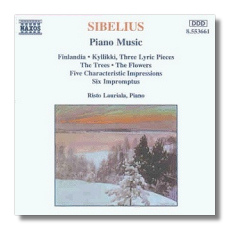
The Internet's Premier Classical Music Source
Related Links
- Sibelius Reviews
- Latest Reviews
- More Reviews
-
By Composer
-
Collections
DVD & Blu-ray
Books
Concert Reviews
Articles/Interviews
Software
Audio
Search Amazon
Recommended Links
Site News
 CD Review
CD Review
Jean Sibelius

Piano Music
- Finlandia, Op. 26/7
- Three Lyric Pieces "Kyllikki" Op. 41
- Piano Pieces "The Trees", Op. 75
- Five Pieces "The Flowers", Op. 85
- Five Characteristic Impressions, Op. 103
- Six Impromptus, Op. 5
Risto Lauriala, piano
Naxos 8.553661 - 68min
The classical-music public's enthusiasm for the same set of pieces means not only that composers like Gubaidulina are mostly unknown, but also that major areas of beloved composers aren't known. With a show of hands, how many have heard a Tchaikovsky opera, Dvořák's songs, a Mozart short mass, or a Bruckner cantata? Sibelius suffers from the same kind of neglect. The orchestral music gets recorded over and over, but you could probably count on your fingers the CDs of his vocal, choral, and chamber music. I've read and heard variously that Sibelius didn't know how to write for the piano (he was a violinist), that the piano works were weak sisters compared to the symphonies, and that he wrote piano music solely for the money.
Logically, we can easily refute all three objections. To paraphrase Dr. Johnson, only a fool doesn't write for money. Motive doesn't speak to quality. Many works, including some by major composers, fail to come up to the level of the Sibelius symphonies or the violin concerto. Furthermore, this kind of comparison recalls the playground argument about whether Spiderman could beat up the Incredible Hulk. Finally, Beethoven and Brahms (both pianists) didn't know how to write for strings, but this doesn't stop musicians from putting in long hours learning to perform their work.
The question remains how good is Sibelius's piano music in itself? Naxos, bless it, provides an inexpensive opportunity to find out.
The present program includes no extended piano piece, à la Beethoven, Chopin, Brahms, or Ravel. We miss the Sonata, Op. 12. Excepting the composer's piano reduction of Finlandia, all the works are suites of short "character pieces," like Mendelssohn's Lieder ohne Worte, Schumann's Kinderszenen, or Grieg's Lyric Pieces. As a matter of interesting fact, Sibelius wrote piano music throughout his career, from the Op. 5 Six Impromptus, through at least the Op. 114 Cinq Esquisses. The Impromptus, filled with shopworn accompaniments and little harmonic movement, provide the most ammunition to dismissive critics, but even here, a flash of the mature Sibelius – a Finlandian turn of melody, an odd modal progression - lights up the salon. Furthermore, he got better. The producer, Matti Heinonen, wisely has the composer push his best work first and leaves the Six Impromptus for the end. By that point, you're willing to indulge.
Praise should also go to Lauriala, whose strong interpretive imagination shapes these works. From the opening Kyllikki, Op. 43, he makes you aware that the works were written by a master symphonist, despite their small compass, and none of these ideas would disappoint you if they had turned up in The Bard or the Symphony #5. Kyllikki shows the Sturm und Drang Sibelius. Lauriala throws out lightning when required, but impresses even more in the second-movement Andantino, which in less-capable hands can come off as disjointed and fragmentary because of its abrupt shifts and many pauses. Lauriala makes it all cohere, and without resorting to the cheap solution of never taking a breath. In The Trees and The Flowers (both published under the title Five Pieces for Piano, opp. 75 and 85, respectively), Sibelius paints nature. He remarked that "the trees speak to me," and without doubt the little landscapes show that nature indeed affected him deeply. "The Lonely Pine" summons from him another Finlandian chorale, while "The Aspen" makes you see the silver leaves glitter in the wind. "The Daisy" is all high spirits and joy, while "The Carnation" gets a gracious waltz and "The Iris" a shy, delicate dance, almost as if it were peeking in from the wings. The Five Characteristic Impressions, the latest works on the disc, are those of village life, with movements including "The Village Church," "The Fiddler," and "The Oarsman." Here, we get closest to the Norwegian folk-pieces of Grieg, with plenty of charm and real poetry. I don't know enough (or any) Finnish folk music to tell you how much Sibelius has taken. I suspect that whatever he took, he had long since absorbed. Like Vaughan Williams, he ended up writing his own folk music. Lauriala, above all else, makes you both feel the originality of the piano writing and also regret that Sibelius never managed to produce the mature "big piano piece."
About the only real disappointment here is the Finlandia, and most of the problems, I'm convinced, come from Sibelius himself, since he made the arrangement. Obviously, the composer conceived the work from the beginning as an orchestral piece, with contrasts a matter of color rather than of contrapuntal texture. His main problem is that he doesn't know how to get the piano to suggest the orchestra, and thus he resorts to a lot of tremolo or makes the elementary mistake of trying to throw every orchestral line to the keyboard. It's most obvious at the "rapid-fire" chords from the brass and strings, and Lauriala barely has time to retrieve the next thematic group. It all sounds rushed and out of breath. The glorious big tune comes off well, however. What a find that melody was!
The sound is well-recorded, without fuss. For those interested, at least eight volumes of Sibelius's piano music are currently available on BIS, played by E. T. Tawaststjerna. If you're not sure you want to satisfy your "completist" desires, this very interesting CD makes an attractive option.
Copyright © 1996, Steve Schwartz


















